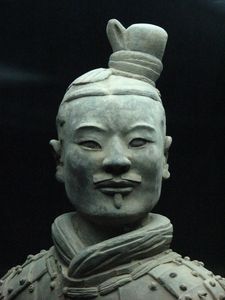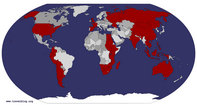Advertisement
Published: August 9th 2007

 Infantryman
Infantryman
Terracotta Army - Pit 2Our trip to Xi'an was a slog, though I won't arouse any sympathy when I say we went soft-sleeper. The first leg of the journey was overnight from Dunhuang to Lanzhou. We had the pleasant surprise of a compartment to ourselves and also tried out the dining car, where we were the only occupants not ignoring the "No Smoking" signs and were lucky that another passenger helped us to decipher the handwritten hanzi menu.
At Lanzhou, LA Woman was hoping to find a Poste Restante package from home but unfortunately it seemed to have gone astray in the Chinese postal system. Since it was already nearly a week later than expected, there didn't seem much point in hanging around so we boarded a train to Xi'an.
Though I hadn't realised it when buying the tickets, we were on the train doing the Lhasa->Beijing run, a 2-day marathon that celebrated its 1-year anniversary the day before we rode it. It was more modern than our previous train but seemed to have less space in the compartments. The brochure revealed that there were oxygen ports available for passengers encountering discomfort at the higher altitudes closer to Tibet. Of more importance, passengers
celebrating their birthday during the journey qualified for free noodles, and the slippers provided to soft-sleeper customers were of different colours. Other services included the provision of "free-poison cups" and "anti-smell shots cover". It's astounding that, in a budget of millions if not billions of yuan to build the link, the translation of the brochure into English was seemingly entrusted to Babelfish.
We arrived in Xi'an in the evening, glimpsing the lights on the city walls blurred by rain. Our abode was a hostel, the first one I've stayed in since my Australia trip and giving me immediate reminders of why I'd loved and loathed such establishments.
Though Xi'an was far and away the most (foreign) touristed place we'd visited in China, we were still subjected to many stares and comments. The density of Western fast food was higher than even Chengdu and I reacquainted myself with the heavenly start to the day that a sausage and egg McMuffin can provide.
Investigations revealed that our next intended destination, Hong Kong (which is considered a separate territory from a visa point of view and hence would allow us to exit China), would be only slightly more expensive to
reach by plane as by train, with the plane (obviously) offering a considerable time saving, so we decided to spend our final week in China in Xi'an.
The weather we had in Xi'an oscillated between grey raininess and uncomfortably hot humidity, making me highly disinclined to go out. The city itself has a few temples dotted around that bely its otherwise modern exterior, and the grid layout of the streets is one of several indications that Xi'an was the imperial capital for 2,000 years until 1,000AD.
As a tourist destination, Xi'an is world-famous for the Terracotta Warriors, an underground army constructed 2 millenia ago to guard the tomb of Qin Shi Huang, emperor of the very first Chinese dynasty. Qin Shi Huang was something of a despot, mixing progressive policies (e.g. standardising weights and measures, enforcing a unified script) with acts of historical revisionism (e.g. ordering the destruction of all books except those concerning either practical topics or the history of the Qin) and sheer ruthlessness (e.g. press-ganging millions of his subjects for construction projects then working them to exhaustion or, often, death).
Further increasing the tourist industry's debt to him was his initiation of the building
of the Great Wall. There is a certain irony to the fact that one of his two most famous projects was designed to keep foreigners out, and the other was never supposed to be seen by anyone, yet both now receive thousands of visitors per year from all over the globe. It's doubtful the irony would be appreciated by either the many labourers worked to death building the wall, or the roughly 70,000 craftsmen executed at the conclusion of the Terracotta Warriors' construction in order to keep its whereabouts secret.
We chose a rainy afternoon on which to visit the Warriors, reasoning that most tour groups would go in the morning and that the weather would deter casual visitors. Neither was a correct assumption, meaning you would have to wait your turn to get to the optimal vantage points for photo purposes. The excavations are in 3 pits, each covered by airport-style hangars. We first went to Pit 1, currently the largest of the 3. It felt like entering a government base where an alien landing was being kept secret, with the hangar stretching away into the distance, the roof excessively high, the view unbroken by any central supports,
walkways around the perimeter and, facing the entrance with stony faces unchanged in 2 millenia, the ranks of the Warriors defending their emperor from the tourist onslaught. The first 50m or so of the hangar contains Warriors in situ, below the level of the walkway but at the rear of the hangar there are a number at eye-level.
Originally the figures wore leather armour over brightly coloured clothing and carried real weapons - the armour and pigments have long decayed, but some of the weapons have been found, with their realism even extending to arrow tips containing poisonous lead. Though the bodies were mass-produced, the head and hands of each soldier were individually crafted, leading to speculation that the figures represent actual members of the Imperial Guard.
Pits 2 and 3 were not as spectacular as Pit 1, though several intact figures excavated from Pit 2 - an infantryman, officer, cavalryman, and archer - were on display in glass cases and gave you an opportunity to see their detail up close. In addition, there was a museum containing 2 bronze chariots recovered from the site.
The tomb of Qin Shi Huang, which the army was supposed to
be guarding, was itself a thing of wonder, at least according to rumours mentioned in accounts written only a century after its construction. An entire underground city was built to house the tomb, containing among other things a bronze map of the world on the floor, with rivers and seas of mercury. Though the tomb site has not yet been excavated (a surprising oversight on a par with the apparent lack of excavation activity at the Warriors themselves), high concentrations of mercury in the surrounding earth would seem to at least partially corroborate these accounts. It may well be that Qin Shi Huang's most spectacular legacy is yet to be revealed.
The most interesting activity in the city itself was walking along the city walls. You can do a complete circuit, totalling about 12km, atop the walls on a path that is as broad as a road but mercifully free of the crazy traffic on the streets below. Late afternoon is probably the best time to begin your perambulation, as you'll then experience the sun setting, the many red lanterns lining the path being turned on, and the gradual illumination of the city's plentiful neon lights.
Xi'an nightlife
was a bit of a bust, though. Even on a Saturday night, every establishment on so-called "Bar Street" had hired singer/guitarist types or - worse - karaoke as entertainment from about 9PM onwards. This was such an anticlimax as earlier the area had been resounding to Eurocheese - I even heard a cover of "Go Go Yellow Screen".
As Xi'an was our last major stop in China, it gave me time to reflect on my impressions after 2.5 months in the country, with the main one being the surprising level of friendliness we'd encountered. Second would be people's general lack of interest in wanting to take advantage of us as clueless Western tourists, which was so different to many Asian countries as to be noteworthy. The sheer variety of landscapes and culture was not something I'd been expecting before opening the guidebook.
The negatives would have to be the usual ones, with smoking absolutely everywhere being my personal favourite (you couldn't avoid it once you'd ventured out of your room), followed by spitting, public toilets being in direct competition with India's for the title of world's worst, etc. I personally didn't mind being stared at or talked about
as it usually appeared to be out of curiosity rather than ridicule. The lack of English speakers (and my own lack of Mandarin) meant more than a few meals that were either way too spicy or containing body parts I had no interest in consuming, as well as several situations where we just couldn't do something because communication was impossible, but the language barrier was on the whole more of an interesting challenge.
What was very clear though was that China as a traveller's destination is changing more rapidly than most countries. A 2 year old guidebook here is as useful as a 10 year old one, i.e. not very. The Internet is the best source of info but even there you have to trawl through umpteen sites (oh for a Chinese Travelfish). For a country with such a good infrastructure, there are surprisingly few independent travellers, certainly in the areas we went to.
I'll definitely be back.
Dull but possibly useful info Getting there: Take a train from Dunhuang to Lanzhou (possibly only one per day - we took the 7:30PM), costing 262 yuan for soft sleeper upper berth and taking about 13 hours 45 minutes,
then take a train to Xi'an (many through the day - we took the 12:36PM), costing 260 yuan for soft sleeper upper berth and taking about 9 hours. I'm not sure if there are any direct trains.
Stayed at: Hang Tang hostel (sister hostel to Shuyuan International Youth Hostel). Cost 140 yuan (with a Hostelling International card) for a double. Good location, free Internet, and very helpful staff. Would stay here again.
Notes: i. Go to see the Warriors first thing in the morning as I think that's the only way to avoid the tour groups. Take bus number 306 from just outside the train station - it takes 1 hour and costs 7 yen, and terminates at the Warriors. It costs 90 yuan to get in to the Warriors. Audio guides are 20 yuan (plus a deposit of 200 yuan) but the booth closes at 4:30PM (i.e. a while before the site does) - note that it takes at least 2 hours to see everything in the site. There are no restrictions on taking photos except that you aren't supposed to use flash or tripods - however I saw many people using flash and a couple using tripods without
them being reprimanded.
Advertisement
Tot: 0.206s; Tpl: 0.014s; cc: 8; qc: 24; dbt: 0.1631s; 1; m:domysql w:travelblog (10.17.0.13); sld: 1;
; mem: 1.1mb


























Mj
non-member comment
RE:
Amazing pictures and interesting details. Cant wait to pack my bag and leave for China. Ps. How do you pronounce these names, like Xi'an, Shaanxi ???? mj